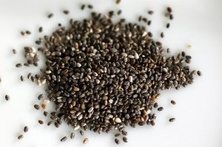AARP Eye Center
Why the New Craze for Chia Seeds?
By Candy Sagon, July 1, 2013 07:15 AM

Remember the chia pets from the '70s, those cute little clay animals that grew green "hair" from sprouting seeds on top of their heads? These days it's chia seeds - cousins of those used in the kitschy figurines - that are the current craze for the health benefits they pack.
The tiny seeds are being used as a topping for yogurt, mixed into cereal or muffins, and added to energy bars, superfood smoothies and desserts. I just ate a delicious coconut milk custard studded with dark chia seeds and topped with raspberries at a restaurant, similar to this recipe from An Edible Mosaic.
Chia seeds, native to Mexico and South America, come from a plant called Salvia hispanica and are packed with omega-3 fatty acids, protein, dietary fiber, antioxidants, and minerals like manganese and calcium. The seeds can be black or white.
Chia has been around for ages - the Mayans and Aztecs prized them as a way to boost energy. Today the superseeds are being touted for their cardiovascular benefits, for helping regulate blood sugar levels, and maybe even helping with weight control by controlling hunger. This may be because when the seeds are soaked in liquid, they form a gel-like consistency - one reason they're so great in puddings - which may help you feel full longer.
Eating Well magazine reported on a small 2007 study that found that those with Type 2 diabetes who added about four tablespoons of chia seeds to their diet for 12 weeks had improvements in blood pressure and reduced inflammation, but the science on the seeds is still scant.
Still, there's no doubt that chia seeds are nutritious - and they don't need to be ground, like flax seeds do, to provide benefits from their nutrients.
An ounce, or about two tablespoons, contains 18 percent of your daily required amount of calcium, 35 percent for phosphorus, 24 percent for magnesium and about 50 percent for manganese, according to the government's nutrient data. Those two tablespoons also contain a whopping 10 grams of fiber - one-third of the recommended daily amount.
How should you use chia seeds? Sprinkle them on your oatmeal or granola; add them to your favorite yogurt; stir them into rice or pasta; top your salad with them. They have a mild nutty flavor, and just a tablespoon a day is a good way to boost your nutrition.
One delicious, easy way to try them: this blueberry-orange smoothie from cookbook author and AARP contributor Pam Anderson.
Photo: flickr/com
Also of Interest
- Surgery Overkill: Why Do We Love Robotic Procedures?
- Hail Kale! Why You Should (or Shouldn't) Eat It
- Join AARP: Savings, resources and news for your well-being
See the AARP home page for deals, savings tips, trivia and more































































